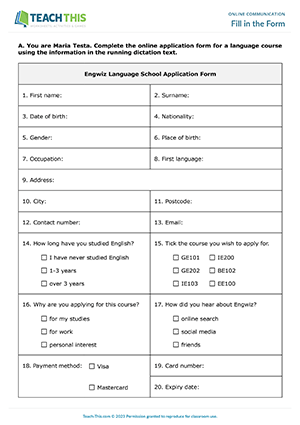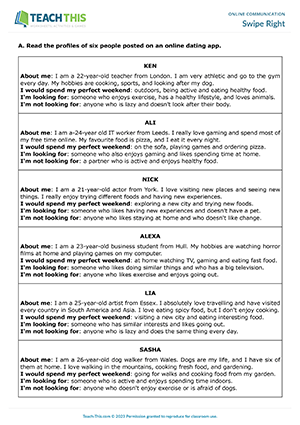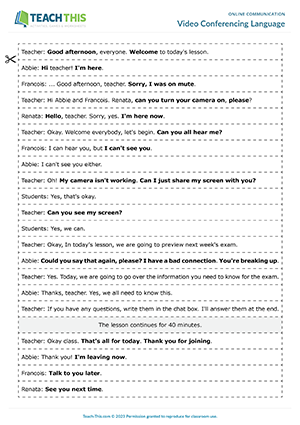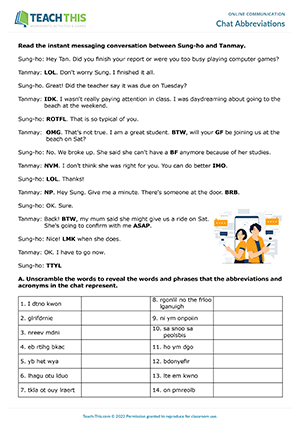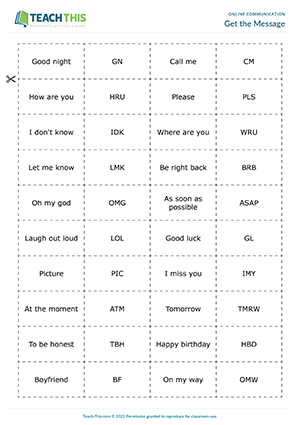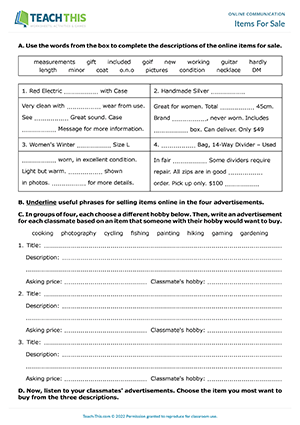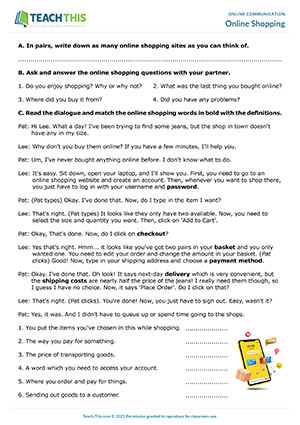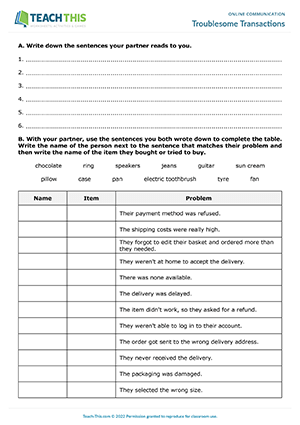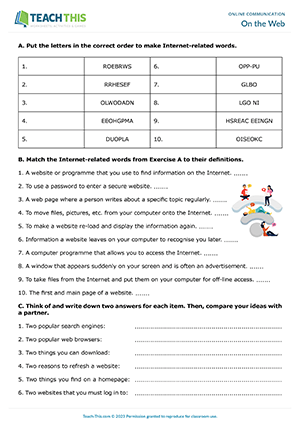In this useful online forms activity, students practice completing forms used for online transactions with personal details. First, in pairs, students take part in a running dictation. The readers stand up, run to a text about someone's personal details, read a sentence or two, run back and dictate what they read to their partner, who writes it down. This continues until the text has been fully dictated. When the students have finished, the readers sit with the writers to check their text. Students then complete an online application form for a language course using the information from the text. Next, students match keywords in the online application form with their definitions. Lastly, students match the words to another person's details.
This fun online dating worksheet helps introduce students to online profiles. Students start by reading the profiles of six people on a dating app. Students then complete sentences about the people with the correct person's name. Next, in pairs, students discuss and write down which of the six people they think would be suited to each other, giving reasons for their choices. Working alone, students then write an online profile of their own. Lastly, students take turns reading out another student's profile to the class, who try to guess whose it is.
In this productive video conferencing language activity, students practice vocabulary and language used in online conference calls. First, in pairs, students arrange sentence strips to create a logical and coherent video conferencing dialogue. Students then match video conferencing words to their definitions. After that, students categorise expressions from the dialogue in a table according to their functions. Next, in groups of three, students use the phrases to create a video conferencing dialogue for an online class or meeting with three participants. Students practice the dialogue three times, taking turns to be the host. Finally, each group presents their dialogue to the class.
In this free chat abbreviations worksheet, students learn and practice instant messaging abbreviations and acronyms that people often use in online chats and text messages. Students begin by reading an instant messaging conversation between two friends. Students then unscramble words to reveal the words and phrases that the abbreviations and acronyms in the chat represent. Next, students write the chat abbreviations next to their definitions. Finally, students complete sentences with the chat abbreviations from the worksheet.
Here are two engaging text message abbreviations and acronyms games for intermediate students. First, students play a pelmanism game. In pairs, students take it in turns to turn over a phrase card and an abbreviation card. If the phrase matches with the messaging abbreviation or acronym, the student wins, keeps the two cards and has another turn. The student with the most pairs of cards at the end of the game wins. Next, students play a betting game using the text message abbreviations and acronyms. Working alone, students read sentences and decide which messaging abbreviation or acronym from the pelmanism game can be used to complete each sentence. Afterwards, students bet on their answers, depending on how confident they feel about their decisions. Students bet between 1 to 10 points on each sentence and write their bet in the 'bet' column. If students guess correctly, they transfer the amount written in the 'bet' column to the 'win' column. If they guess incorrectly, they transfer the amount to the 'lose' column. The student with the most points at the end is the winner.
In this handy online advertisements activity, students read and write descriptions of items for sale. First, students use words from a box to complete descriptions of online items for sale. Students then identify useful phrases for selling items online in the advertisements. Next, in groups of four, each group member chooses a different hobby from the worksheet. After that, students write an advertisement for each classmate based on an item that someone with their hobby would want to buy. For example, if one student chooses fishing as a hobby, a group member might choose to write an advertisement for a fishing rod. Finally, students take turns reading their advertisements to their classmates who choose the item they most want to buy based on the three descriptions.
In this comprehensive online shopping worksheet, students practice vocabulary associated with shopping online. First, in pairs, students list popular online shopping sites and then ask and answer conversation questions about shopping online. Students then read a conversation between two friends about online shopping and match words in the dialogue with their definitions. Next, students match verbs with endings to make imperative statements about shopping online. Students then move on to complete sentences using online shopping vocabulary. Following that, students decide whether statements about online shopping are advantages or disadvantages and categorise them accordingly. Lastly, students discuss whether they prefer shopping online or in-store with their partner.
This enjoyable online transactions activity helps students practice language for transacting online. In pairs, one student is the reader, and the other is the writer. The reader runs to their sentence sheet on the wall outside the classroom, reads the first sentence, runs back and dictates it to their partner, who writes it down. This continues until all six sentences have been fully dictated. Students then swap roles, and the process is repeated with another set of sentences. Next, pairs refer to the information they wrote down and race to complete a table about online transactions people made, matching each person and the item they bought or tried to buy with a problem. The first pair to correctly complete the table wins. Afterwards, check the answers as a class and review the vocabulary and phrases related to online transactions.
In this insightful Internet vocabulary worksheet, students practice words related to using the Internet. First, students unscramble words related to the Internet. Students then match the Internet words to their definitions. Next, students think of and write down two examples for each Internet-related item and then compare their answers with a partner. After that, students use words from a box to complete facts about the Internet. Finally, students underline the correct word or phrase to complete each Internet conversation question and then ask and answer the questions with a partner.
Latest Free
Resources
- Everyday Objects Bingo
Everyday Objects
Elementary (A1-A2)
- Action Verb Races
Actions
Elementary (A1-A2)
- Birthday Basics
Birthdays
Elementary (A1-A2)
- Sales Phrasal Verbs
Business Phrasal Verbs
Upper-intermediate (B2)
Latest Member
Resources
- Collocations at Work
Business Collocations
Intermediate (B1)
- Etiquette Trivia Board Game
Etiquette and Manners
Upper-intermediate (B2)
- Everyday Objects Vocabulary
Everyday Objects
Pre-intermediate (A2)
- Let's have a talk
Verb-Noun Collocations
Pre-intermediate (A2)



